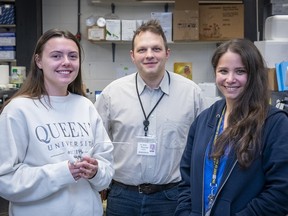Science
Kingston Researchers Unveil Innovative Biopsy Capsule for Brain Cancer

A groundbreaking biopsy capsule developed by a research team in Kingston, Ontario, is set to advance brain cancer research significantly. The team, comprising neurosurgeons and a graduate student from the Kingston Health Sciences Centre (KHSC) and Queen’s University, has created a world-first 3D-printed surgical biopsy capsule designed to collect tissue samples from brain tumours with unparalleled precision.
The innovation stems from the collaborative efforts of neurosurgeon scientists, Dr. James Purzner and Dr. Teresa Purzner, alongside Queen’s engineering PhD candidate Kaytlin Andrews. According to a media release from KHSC, this new tool allows researchers to gather numerous tissue samples linked to MRI imaging, enabling a comprehensive study of the molecular characteristics of glioblastoma tumours.
Innovative Approach to Tumour Sampling
Dr. Teresa Purzner highlighted the challenges posed by the heterogeneity of glioblastoma, stating, “There are so many differences within the tumour, and between tumours from one patient to another.” Traditional methods limited researchers to small, arbitrarily collected tissue fragments, often leading to incomplete understandings of the tumour. She likened this to looking at an elephant through small peepholes, missing the broader picture.
The team aimed to overcome these limitations by developing a tool that facilitates more comprehensive sampling of the tumour. “We’re trying to get a clearer view of the elephant as a whole,” Dr. Purzner explained. This initiative aligns with her broader efforts to improve brain tumour treatment pathways through KHSC’s Integrative Brain Tumour Program, which focuses on enhancing connectivity among patients and healthcare professionals.
The development process involved a unique engineering approach, with Andrews leading the design of the biopsy tool. “We listed all the features needed from safety, clinical, and scientific perspectives, and then identified the engineering attributes required to meet those needs,” Dr. Purzner noted. The tool was refined through feedback from six of the eight neurosurgeons at KHSC, who tested its effectiveness against traditional biopsy methods.
Positive Early Results and Future Potential
Initial tests demonstrated that the new biopsy capsule is both quicker and more consistent than existing tools. Remarkably, graduate students with minimal surgical experience could effectively use the device after just a brief instructional video. “The usability and intuitiveness of the device were so high that students were able to obtain samples more quickly and reliably than experienced surgeons using standard tools,” Dr. Purzner stated.
Already approved for human use, the biopsy capsule is currently employed exclusively at KHSC, making it the only medical centre globally to utilize this innovative Canadian technology. The capsules are produced through standard 3D printing techniques, costing around $0.30 each, making them easily accessible for hospitals worldwide.
KHSC is working to establish partnerships with other hospitals across Ontario to expand the study of this technology. Plans are underway for a state-of-the-art tissue banking facility designed to store samples from patients throughout Canada, positioning KHSC and Queen’s University as a pivotal hub for brain tumour research.
Dr. Purzner expressed optimism regarding the potential of the biopsy capsule to explore new treatment avenues. These include targeted radiation therapies for high-risk tumour areas and enhanced surgical techniques to improve tumour removal precision. “This will allow us to gain a new perspective on a disease where it has been challenging to create new therapies,” she said.
Despite recent promising trials in adult brain cancer, Dr. Purzner emphasized the field’s stagnation in developing new drugs over the past several decades. “There’s utility in approaching the problem from a different angle, especially when traditional methods have not yielded significant progress,” she said.
As the Kingston team continues to refine their approach and expand their research, there is hope that this innovative biopsy tool will lead to breakthroughs in the understanding and treatment of glioblastoma, ultimately improving patient outcomes in this challenging area of medicine.
-

 Science3 months ago
Science3 months agoToyoake City Proposes Daily Two-Hour Smartphone Use Limit
-

 Top Stories3 months ago
Top Stories3 months agoPedestrian Fatally Injured in Esquimalt Collision on August 14
-

 Health3 months ago
Health3 months agoB.C. Review Reveals Urgent Need for Rare-Disease Drug Reforms
-

 Technology3 months ago
Technology3 months agoDark Adventure Game “Bye Sweet Carole” Set for October Release
-

 World3 months ago
World3 months agoJimmy Lai’s Defense Challenges Charges Under National Security Law
-

 Lifestyle3 months ago
Lifestyle3 months agoVictoria’s Pop-Up Shop Shines Light on B.C.’s Wolf Cull
-

 Technology3 months ago
Technology3 months agoKonami Revives Iconic Metal Gear Solid Delta Ahead of Release
-

 Technology3 months ago
Technology3 months agoApple Expands Self-Service Repair Program to Canada
-

 Technology3 months ago
Technology3 months agoSnapmaker U1 Color 3D Printer Redefines Speed and Sustainability
-

 Technology3 months ago
Technology3 months agoAION Folding Knife: Redefining EDC Design with Premium Materials
-

 Business3 months ago
Business3 months agoGordon Murray Automotive Unveils S1 LM and Le Mans GTR at Monterey
-

 Technology3 months ago
Technology3 months agoSolve Today’s Wordle Challenge: Hints and Answer for August 19









